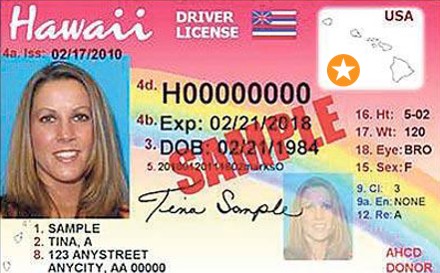Traveling to Hawaii is a dream for many, and you might be wondering, “Can You Travel To Hawaii Without A Passport?” The good news is, for U.S. citizens, a passport is generally not required for travel to Hawaii. TRAVELS.EDU.VN is here to provide you with comprehensive guidance on identification requirements, ensuring your Hawaiian getaway is smooth and stress-free. This includes information on REAL ID compliance, acceptable forms of identification, and tips for traveling with children, alongside details about Hawaiian travel requirements, documentation for Hawaii trips, and acceptable ID for Hawaii.
1. Domestic Travel to Hawaii: What You Need to Know
For U.S. citizens, traveling to Hawaii from any of the 50 states is considered a domestic flight. This means the identification requirements are the same as traveling between any other two U.S. states. A valid government-issued photo ID is typically sufficient.
1.1 Acceptable Forms of Identification
The Transportation Security Administration (TSA) accepts several forms of identification. Here are some of the most common:
- U.S. passport
- U.S. passport card
- Driver’s license or other state photo identity card issued by the Department of Motor Vehicles (or equivalent)
- U.S. military ID
- Permanent resident card (Green Card)
- Trusted Traveler cards (Global Entry, NEXUS, SENTRI, FAST)
- DHS-designated enhanced driver’s license
- Airline or airport-issued ID (if issued under a TSA-approved security plan)
For a comprehensive list, you can visit the TSA website.
1.2 REAL ID Act and Its Impact
The REAL ID Act establishes minimum security standards for state-issued driver’s licenses and identification cards. Beginning May 7, 2025, every air traveler 18 years of age and older will need a REAL ID-compliant driver’s license, state-issued enhanced driver’s license, or another acceptable form of ID to fly within the United States.
What is a REAL ID?
A REAL ID-compliant card is usually marked with a star in the upper portion of the card. This indicates that the state has met the federal requirements for identification.
 REAL ID Example
REAL ID Example
Image: Example of a REAL ID card with a star marking.
How to Obtain a REAL ID:
To obtain a REAL ID, you will need to visit your state’s Department of Motor Vehicles (DMV) and provide documentation proving your identity, Social Security number, and address. Check the DHS REAL ID website for specific requirements in your state.
1.3 Traveling with Children
Children under 18 years old are not required to show identification when traveling with an adult companion who has a valid ID. However, it’s recommended that children carry some form of identification, such as a school ID card or a copy of their birth certificate. If you are traveling with a lap infant, you may be asked to provide proof of the child’s age, such as a birth certificate.
1.4 What if You Don’t Have an Acceptable ID?
If you arrive at the airport without an acceptable form of identification, you may still be allowed to fly. The TSA officer will ask you to provide other information to verify your identity. If your identity can be confirmed, you will be allowed to proceed through security. However, this process can be time-consuming, so it’s always best to have a valid form of identification.
1.5 Tips for a Smooth Check-In
- Double-check that your ID is valid and unexpired before heading to the airport.
- If you are getting a REAL ID, make sure to gather all required documents ahead of time to avoid delays at the DMV.
- Consider enrolling in TSA PreCheck to expedite the security screening process.
2. International Travel: Passport Requirements
If you are not a U.S. citizen, or if you are traveling to Hawaii from a foreign country, you will need a valid passport.
2.1 Passport Validity
Your passport should be valid for at least six months beyond your intended stay in Hawaii. Some countries also require that your passport have at least one or two blank pages.
2.2 Visa Requirements
Depending on your citizenship, you may also need a visa to enter the United States. Check the U.S. Department of State website or contact the U.S. embassy or consulate in your country for more information.
2.3 Electronic System for Travel Authorization (ESTA)
If you are a citizen of a country that participates in the Visa Waiver Program (VWP), you may be able to travel to the United States without a visa by applying for an Electronic System for Travel Authorization (ESTA). An ESTA is valid for two years or until your passport expires, whichever comes first.
2.4 Other Documents
Besides the passport, you may need other documents for international travel, such as the I-94 form. This form is used by U.S. Customs and Border Protection (CBP) to track the entry and exit of foreign visitors.
3. Specific Situations and Scenarios
Certain situations may require specific documentation or have different requirements.
3.1 Military Personnel
Active-duty U.S. military personnel and their dependents have specific guidelines. Generally, active-duty military members can use their military ID for domestic flights. Dependents over the age of 18 will need a REAL ID-compliant driver’s license or other acceptable form of ID.
3.2 Law Enforcement Officers
Law enforcement officers (LEOs) traveling with a firearm must comply with TSA guidelines. They must present their credentials and follow specific procedures for declaring their weapon.
3.3 Traveling with Pets
If you plan to travel to Hawaii with your pet, there are specific requirements you need to meet. Hawaii is a rabies-free state, so there are strict quarantine rules to prevent the introduction of rabies. You will need to have your pet vaccinated against rabies and obtain a health certificate from a veterinarian. Check the Hawaii Department of Agriculture website for the latest requirements.
3.4 Emergency Travel
In emergency situations, such as a death in the family, you may be able to obtain expedited passport services. Contact the nearest passport agency or U.S. embassy or consulate for assistance.
4. What to Do If Your ID is Lost or Stolen
Losing your ID while traveling can be stressful, but here are steps to take:
4.1 Report the Loss
Report the loss or theft of your driver’s license to the local police and your state’s DMV. For a lost or stolen passport, report it to the State Department immediately to prevent identity theft.
4.2 Obtain a Temporary ID
If possible, obtain a temporary driver’s license or ID card from the local DMV. If you are overseas, contact the nearest U.S. embassy or consulate for assistance in obtaining a replacement passport.
4.3 Alternative Identification
As mentioned earlier, TSA may accept alternative forms of identification or ask you to provide information to verify your identity. Be prepared to answer questions and provide any documentation you have available.
5. Frequently Asked Questions (FAQ)
Let’s address some common questions about traveling to Hawaii without a passport.
5.1 Do I need a passport to travel to Hawaii if I am a U.S. citizen?
Generally, no. If you are a U.S. citizen traveling directly from another U.S. state, you do not need a passport. A valid government-issued photo ID, such as a driver’s license, is sufficient.
5.2 What if my driver’s license is not REAL ID compliant?
After May 7, 2025, you will need a REAL ID-compliant driver’s license or another acceptable form of ID to fly within the United States.
5.3 Can children travel to Hawaii without identification?
Children under 18 are not required to show ID when traveling with an adult who has a valid ID. However, it is recommended to carry some form of identification for them.
5.4 What documents do I need if I am not a U.S. citizen?
If you are not a U.S. citizen, you will need a valid passport and possibly a visa, depending on your country of citizenship.
5.5 How early should I arrive at the airport for my flight to Hawaii?
It’s recommended to arrive at least two hours before your scheduled departure time for domestic flights and three hours for international flights.
5.6 Can I use my Global Entry card instead of a driver’s license?
Yes, a Global Entry card is an acceptable form of identification for domestic flights.
5.7 What if I lost my ID right before my flight?
Contact the TSA immediately. They may be able to verify your identity through other means.
5.8 Are there any exceptions to the ID requirements?
There are very few exceptions. It’s always best to have a valid form of identification.
5.9 Do I need any special documents if I am traveling with medication?
If you are traveling with medication, it’s a good idea to carry a copy of your prescription. Check the TSA guidelines for traveling with medications.
5.10 Where can I find the most up-to-date information on travel requirements?
Check the TSA and U.S. Department of State websites for the latest information.
6. Planning Your Trip with TRAVELS.EDU.VN
Planning a trip to Hawaii involves more than just knowing the ID requirements. You also need to consider accommodations, activities, and transportation. TRAVELS.EDU.VN can help you with all aspects of your trip planning.
6.1 Accommodation Options
Hawaii offers a wide range of accommodation options, from budget-friendly hotels to luxury resorts. Popular choices include:
- Luxury Resorts: The Ritz-Carlton Residences, Waikiki Beach; Four Seasons Resort Hualalai
- Mid-Range Hotels: Hyatt Regency Waikiki Beach Resort & Spa; Sheraton Princess Kaiulani
- Budget Hotels: Aqua Aloha Surf Waikiki; Polynesian Hostel Beach Club
| Hotel Name | Average Price per Night | Amenities | Location |
|---|---|---|---|
| The Ritz-Carlton Residences | $800+ | Spa, multiple restaurants, ocean views | Waikiki Beach |
| Hyatt Regency Waikiki | $400+ | Pool, restaurants, beach access | Waikiki Beach |
| Aqua Aloha Surf Waikiki | $200+ | Pool, kitchenette | Waikiki |
6.2 Activities and Attractions
Hawaii is known for its stunning natural beauty and offers a variety of activities:
- Beaches: Waikiki Beach, Hanauma Bay, Poipu Beach
- Hiking: Diamond Head, Volcanoes National Park
- Cultural Sites: Pearl Harbor, Polynesian Cultural Center
- Water Sports: Surfing, snorkeling, scuba diving
6.3 Transportation Options
Getting around Hawaii is easy with various transportation options:
- Rental Cars: Available at all major airports.
- Shuttles: Airport shuttles and island shuttles.
- Public Transportation: TheBus on Oahu.
- Taxis and Ride-Sharing: Uber and Lyft are available.
7. Why Choose TRAVELS.EDU.VN?
TRAVELS.EDU.VN is committed to providing you with the best travel planning experience. Here are some of the benefits of choosing us:
- Expert Advice: Our team of travel experts can provide you with personalized recommendations and advice.
- Wide Range of Options: We offer a wide range of accommodation, activity, and transportation options to suit your needs and budget.
- Competitive Prices: We work with top travel providers to offer you the best prices.
- 24/7 Support: Our customer support team is available 24/7 to assist you with any questions or concerns.
8. Experience the Aloha Spirit with Confidence
Traveling to Hawaii is a memorable experience. By understanding the identification requirements and planning your trip with TRAVELS.EDU.VN, you can travel with confidence and enjoy everything the islands have to offer. From the stunning beaches to the vibrant culture, Hawaii has something for everyone.
Ready to start planning your Hawaiian adventure? Contact TRAVELS.EDU.VN today! Let us help you create the perfect itinerary, find the best deals on accommodations, and ensure you have all the necessary documentation for a smooth and enjoyable trip.
Address: 123 Main St, Napa, CA 94559, United States
WhatsApp: +1 (707) 257-5400
Website: travels.edu.vn
Don’t let the stress of planning get in the way of your dream vacation. Reach out to us now, and let’s make your Hawaiian dream a reality!
